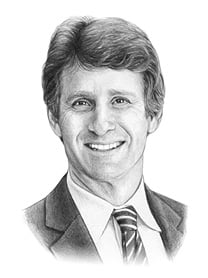What Is Trump’s Foreign-Policy Doctrine?

Analysis
What Is Trump’s Foreign-Policy Doctrine?
Ten thinkers on the start of the U.S president’s second term.
Klawe Rzeczy illustration for Foreign Policy/Getty Images
This article is part of a collection on the second-term president’s approach to the world. Read the full package here.
After U.S. President Donald Trump’s first 100 days in office, is a foreign-policy doctrine coming into view? In the 19th century, the Monroe Doctrine warned European countries to keep out of the Western Hemisphere, and four decades ago, the Reagan Doctrine promised to support freedom fighters around the world.
But what is the defining feature of Trump’s second-term approach to global affairs? Contrary to mainstream assessments that the president is completely unpredictable, there is a reliable worldview underlying his foreign policy, and it consists of three main pillars.
After U.S. President Donald Trump’s first 100 days in office, is a foreign-policy doctrine coming into view? In the 19th century, the Monroe Doctrine warned European countries to keep out of the Western Hemisphere, and four decades ago, the Reagan Doctrine promised to support freedom fighters around the world.
But what is the defining feature of Trump’s second-term approach to global affairs? Contrary to mainstream assessments that the president is completely unpredictable, there is a reliable worldview underlying his foreign policy, and it consists of three main pillars.
First, Trump believes in America First, which is more than a slogan. While former President Joe Biden divided the world between democracy and autocracy—and some U.S. policy wonks talk about allies versus adversaries or the developed versus the developing world—Trump’s mental map draws the key global fault line between the United States and everyone else. In his view, the United States stands apart.
The second pillar of Trump’s second-term doctrine is that the United States is getting ripped off. Washington shoulders too much of the burden of global leadership. Past presidents were foolish or weak, allowing adversaries and allies alike to take advantage of U.S. wealth, power, and goodwill. The results, in his view, are unfair trade deals, free-riding allies, and open borders that facilitate the flow of drugs and criminals from other countries. Trump sees his job as president as righting these wrongs and getting a better deal for the American people.
Third, the method to redress these global imbalances is escalate to de-escalate. As Trump writes in The Art of the Deal, his preferred negotiating strategy revolves around making threats and extreme demands to throw one’s negotiating partner off balance and ultimately bring them crawling to the table for a deal.
To be sure, this three-part framework is simplified, but it explains a large portion of Trump’s foreign policy since he took office in January, including his approaches to border security, Chinese presence in the Panama Canal, NATO burden-sharing, Russia’s war in Ukraine, Iran’s nuclear program, the U.S. trade deficit, and more.
Though tactical unpredictability in his foreign-policy strategy is likely, you can count on these three pillars to serve as a guide to U.S. foreign policy for the next three and a half years.
Matthew Kroenig is a columnist at Foreign Policy and vice president and senior director of the Atlantic Council’s Scowcroft Center for Strategy and Security and a professor in the Department of Government and the Edmund A. Walsh School of Foreign Service at Georgetown University. His latest book, with Dan Negrea, is We Win, They Lose: Republican Foreign Policy and the New Cold War. X: @matthewkroenig
More from Foreign Policy
-

An illustration shows a line of large shopping carts facing down a small Donald Trump figure holding two shopping bags. The stars of China’s flag are in the upper left corner. Why Beijing Thinks It Can Beat Trump
China’s elites have a new confidence in their own system.
-

U.S. Army Chief of Staff Randy George speaks to U.S. soldiers at the Hohenfels Training Area in southern Germany on Feb. 6. A Drawdown of U.S. Forces in Europe Is All but Certain
Here’s how the Pentagon can rebalance its approach to the continent without sacrificing U.S. interests.
-

University of California, Los Angeles students, researchers, and demonstrators rally during a “Kill the Cuts” protest against the Trump administration’s funding cuts on research, health, and higher education in Los Angeles on April 8. Why Authoritarians Attack Universities First
A Yale professor and expert on fascism talks about why he’s leaving the United States under Trump.
-

Dwight D. Eisenhower looks over a piece of paper while sitting on a couch as Robert Cutler looks over his shoulder. How Generations of Experts Built U.S. Power
And now Trump is throwing it all away.








Join the Conversation
Commenting on this and other recent articles is just one benefit of a Foreign Policy subscription.
Already a subscriber?
.
Subscribe
Subscribe
View Comments
Join the Conversation
Join the conversation on this and other recent Foreign Policy articles when you subscribe now.
Subscribe
Subscribe
Not your account?
View Comments
Join the Conversation
Please follow our comment guidelines, stay on topic, and be civil, courteous, and respectful of others’ beliefs.
Change your username |
Log out
Change your username:
CANCEL
Confirm your username to get started.
The default username below has been generated using the first name and last initial on your FP subscriber account. Usernames may be updated at any time and must not contain inappropriate or offensive language.